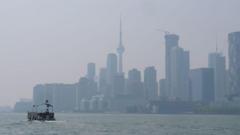The once serene landscape of Ontario Place, a popular oasis in downtown Toronto, is undergoing a significant transformation that promises to alter its character forever. The West Island, one of the two small artificial islands that comprise Ontario Place, has been selected for a new development initiative led by a European spa company. This choice underscores a trend towards commercializing public spaces, sparking debates about the future of urban green areas.
Residents like Francesca Bouaoun, who have cherished the tranquility provided by the expansive green area, were devastated to witness the removal of over 800 mature trees, a crucial part of the island's ecosystem, in early October. Bouaoun, an avid birdwatcher, expressed her distress over the loss of habitat for local wildlife, fearing for the birds that she has watched for years, and lamenting the shifting landscape that was once a refuge during the pandemic.
The decision to strip the land of its natural cover has been met with significant pushback from community members who advocate for preserving these green spaces in the face of commercial expansion. Many local activists feel that the removal of the trees signifies a broader neglect of environmental concerns in favor of profit-driven projects that disregard the intrinsic value of nature in urban settings.
Amidst these concerns, the provincial government's backing of the new water park and spa suggests a pivot towards prioritizing tourism and economic development at the cost of ecological integrity. As the project proceeds, the social and environmental ramifications remain critical points of contention, highlighting the struggle between urbanization and conservation.
While many residents await more clarity on how the project will impact community dynamics, one thing remains clear: the beloved Ontario Place is evolving, and the debates surrounding its development will likely shape Toronto’s waterfront for generations to come. The narrative surrounding this transformation reflects broader discussions about urban development strategies and the importance of sustainable practices in city planning.
Residents like Francesca Bouaoun, who have cherished the tranquility provided by the expansive green area, were devastated to witness the removal of over 800 mature trees, a crucial part of the island's ecosystem, in early October. Bouaoun, an avid birdwatcher, expressed her distress over the loss of habitat for local wildlife, fearing for the birds that she has watched for years, and lamenting the shifting landscape that was once a refuge during the pandemic.
The decision to strip the land of its natural cover has been met with significant pushback from community members who advocate for preserving these green spaces in the face of commercial expansion. Many local activists feel that the removal of the trees signifies a broader neglect of environmental concerns in favor of profit-driven projects that disregard the intrinsic value of nature in urban settings.
Amidst these concerns, the provincial government's backing of the new water park and spa suggests a pivot towards prioritizing tourism and economic development at the cost of ecological integrity. As the project proceeds, the social and environmental ramifications remain critical points of contention, highlighting the struggle between urbanization and conservation.
While many residents await more clarity on how the project will impact community dynamics, one thing remains clear: the beloved Ontario Place is evolving, and the debates surrounding its development will likely shape Toronto’s waterfront for generations to come. The narrative surrounding this transformation reflects broader discussions about urban development strategies and the importance of sustainable practices in city planning.



















